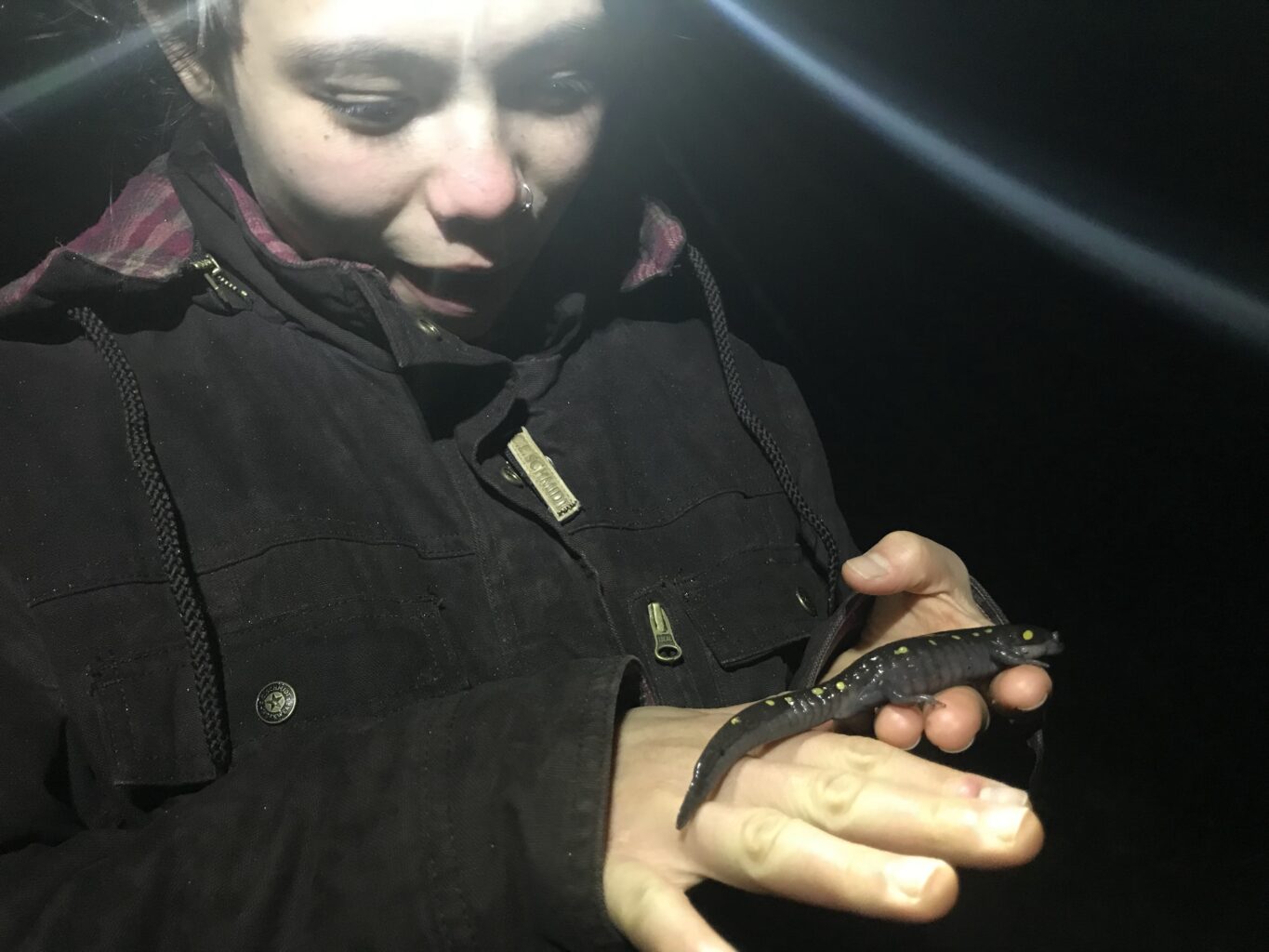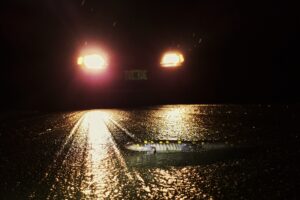Forecast: Rainy, Connection Likely

By Pete Kerby-Miller, Teacher-Naturalist
Memory is oddly tied to mundane details. It might be an anniversary, or a traditional meal, or even a particular scent that pulls us into reminiscence. This late winter afternoon, it’s precipitation. This morning a prodigious snowstorm closed schools, reminding me of the elation of childhood snow days and tromping through fresh powder. The air is warming now, and heavy flakes become sleet, then sleet becomes rain. It’s a disappointing change for the skiers in Montpelier’s parks. I take heart though as I’m transported to a different rainstorm — cold, muddy, and joyous…
Rain beat a frenetic rhythm on my hood as mud sucked at our booted feet. In the din, our headlamps lit falling rain and thick, pressing fog. Maya and I could only shout over the raindrop drumbeat, so we soon fell silent. Our sensory world was just one sodden, muddy dome, plodding along the dark road in intense focus.
“Whoa!” Maya shouted, “It’s huge!” She was fixed in the road, soaked, staring towards her toes. Crawling past was a glistening, brilliantly yellow, bulging-eyed beauty of a Spotted Salamander. “I’ve never seen one!” she grinned, crouching now to take a closer look. We stooped by a puddle for a moment to observe as the migrating salamander paused. Long, fingery hands, slimily creviced skin, and a mouth entirely as wide as their body gave the creature an alien appearance.
Spotted Salamanders, while not uncommon, are very uncommonly seen. They spend the vast majority of their 20 year lifespan mostly underground – emerging only briefly on rainy nights to forage for insects, worms, and smaller salamanders.
Once the ground thaws in April though, the first warm rains draw these usually reclusive amphibians out. In the misty darkness, they’ll migrate once a year from their winter burrows to marshes, ponds, and puddles where they congregate and breed. This journey can be highly synchronized, with every salamander from a given hillside arriving in the breeding pond within a day or two. Sleep through the rainstorm and you’ll miss them.
From our perspective, it was a happy coincidence that brought us to stoop near a muddy pothole so thoroughly graced with a Spotted Salamander. From the salamander’s perspective though, roads are a dangerous obstacle in the course of their migration. This one soon flexed their toes and continued with purpose. We likewise stood to continue our own mission, marking one tally on a rather sodden datasheet.

It was the hope of meeting salamanders that coaxed us out of our homes into this chilly downpour. Contributing to Community Science is what urged us to bring a clipboard. We were taking part in the Amphibian Road Crossing (ARC) program, where hundreds of volunteers journey to backroads on rainy spring nights to count and escort amphibians where their annual migrations perilously cross roads.
The ARC program empowers community members to be directly involved in amphibian conservation. After a short online training, surveyors can find a mapped crossing site on the program’s webpage, print some datasheets, don their most reflective and waterproof getup, and venture out to count and chaperone migrating amphibians. These efforts have real impact: last year alone, surveyors encountered 3,372 amphibians at 99 different sites across the state. Not only does that represent a tremendous win for those individual salamanders and frogs that migrated safely, the breadth and depth of that data is an invaluable resource for conservation planning. Funding for protecting wildlife from car collisions is largely administered at the state level, and ARC surveyors are building a database at that scale to justify and prioritize that spending.
It has been gratifying to watch this program grow. In four years, ARC surveyors have recorded over 17,000 amphibians at 193 sites. Those numbers translate to improved capacity for conservation. In this late winter rainstorm I find myself turning away from digital maps and spreadsheets, though. I watch raindrops race down the window and imagine all those joyous, muddy moments beneath other rainclouds — powerful, connecting, and entirely uncountable.

